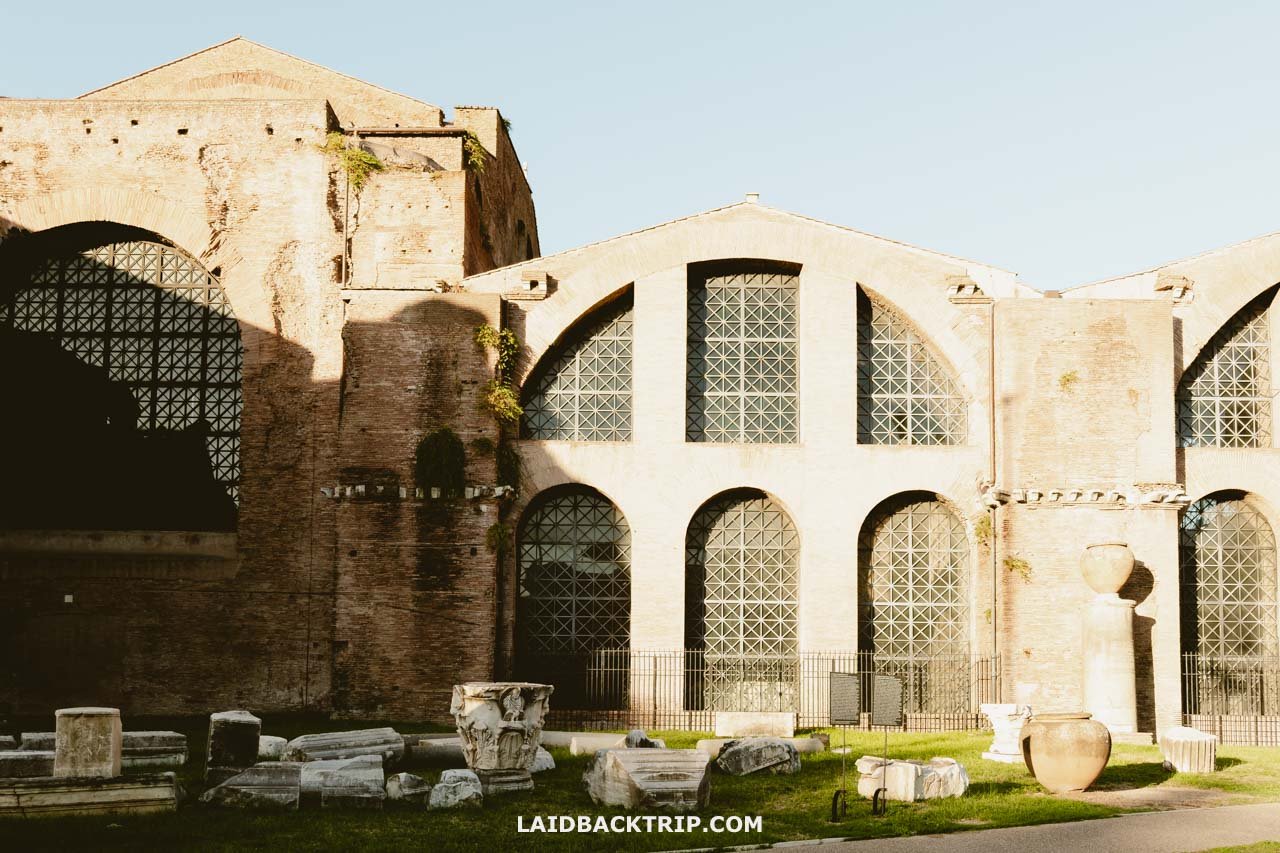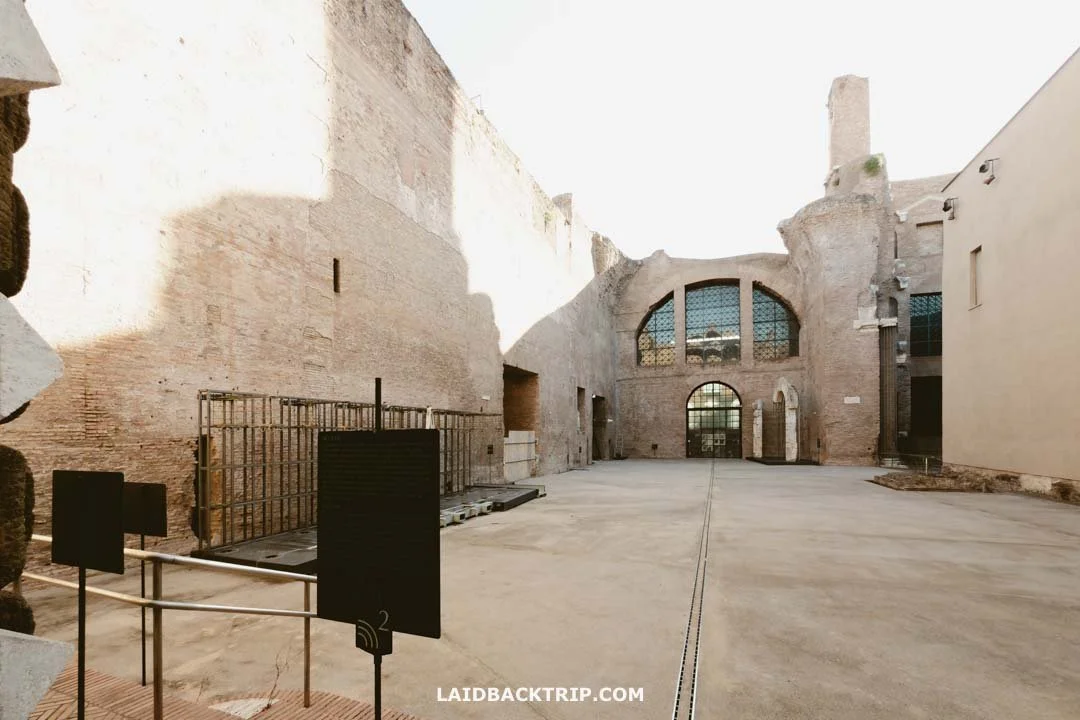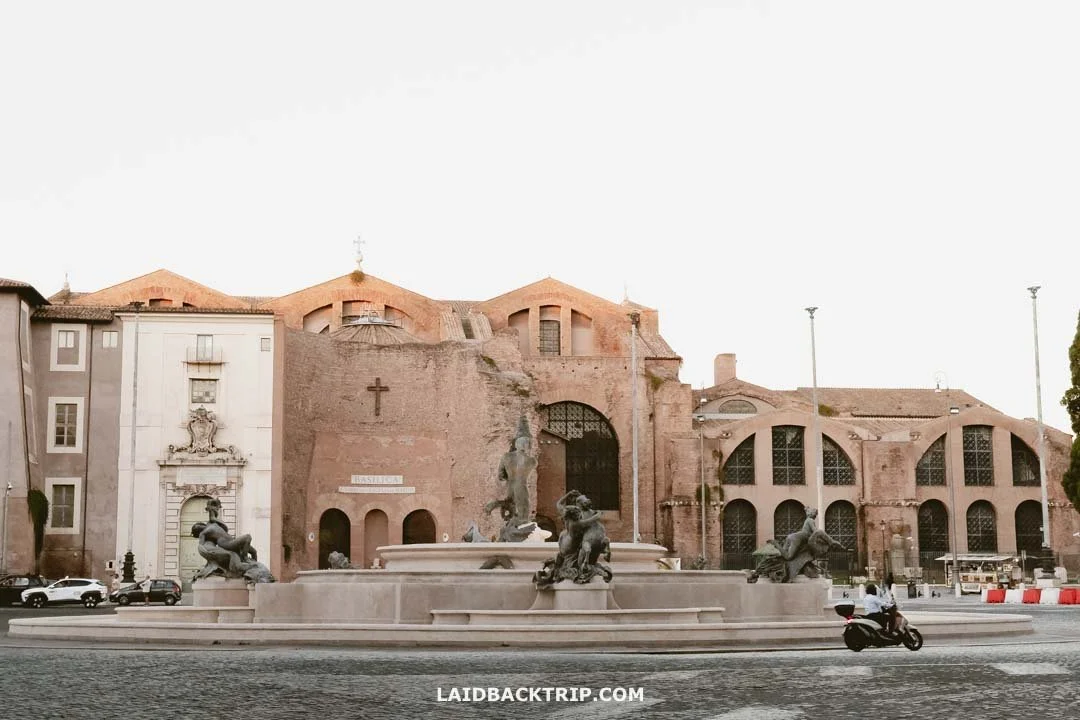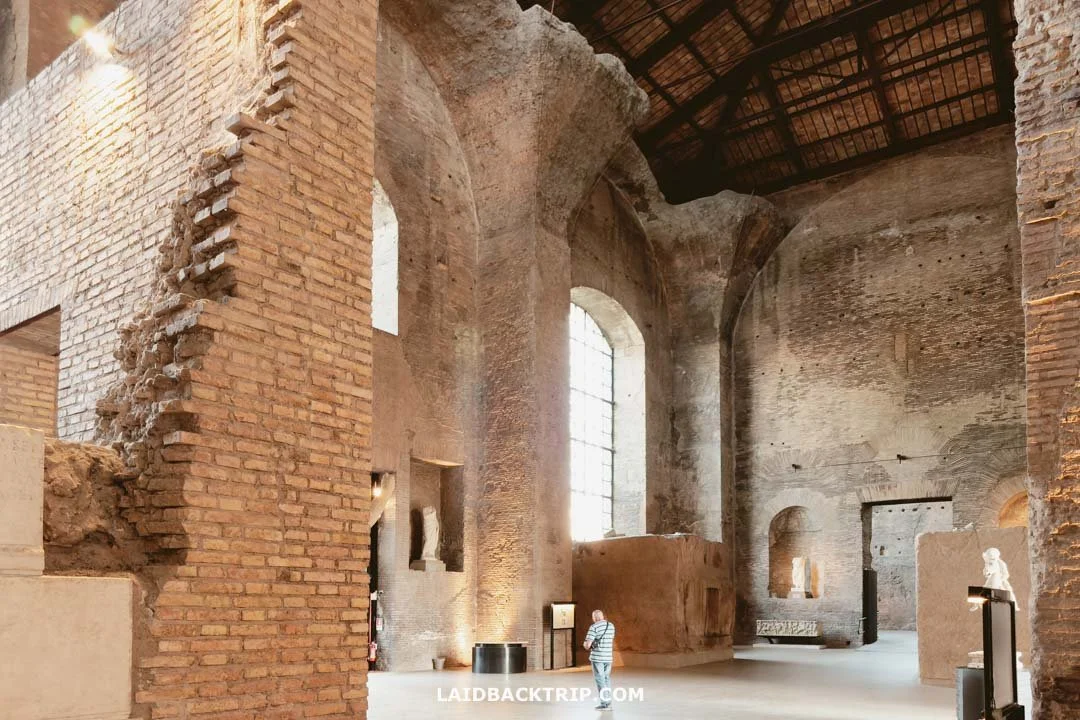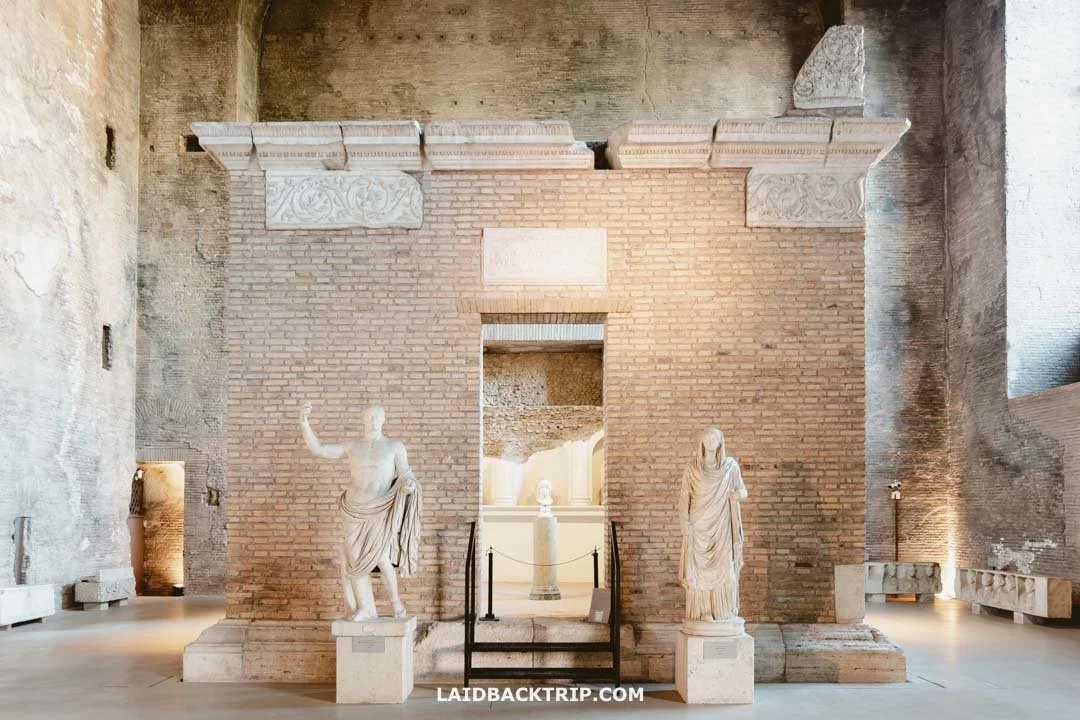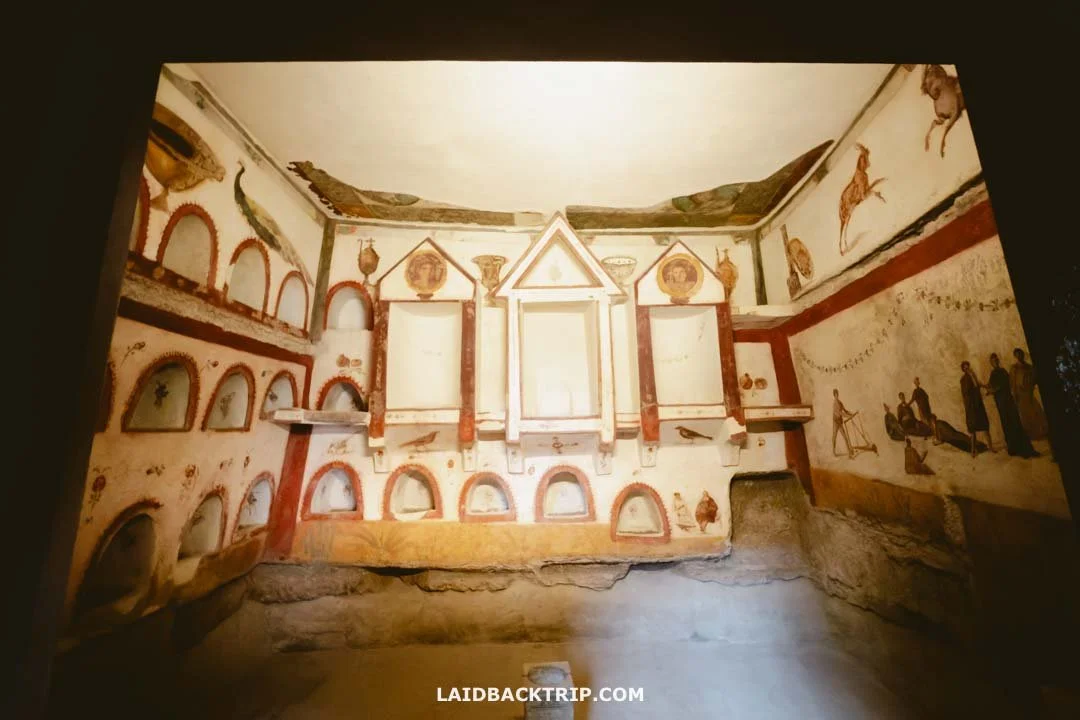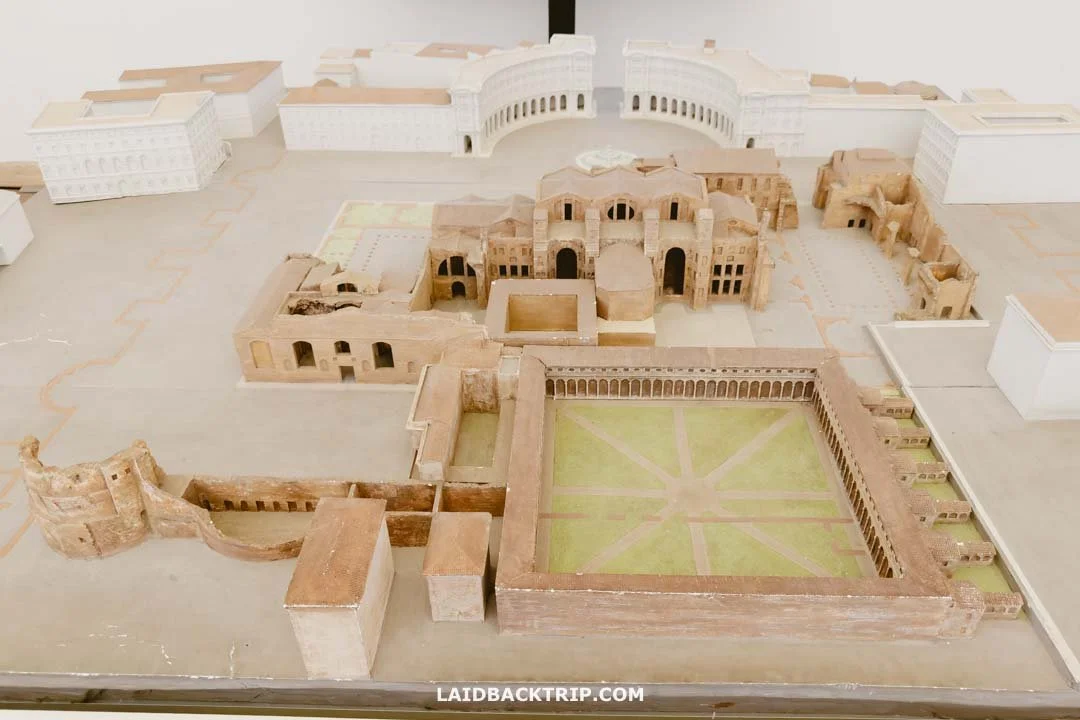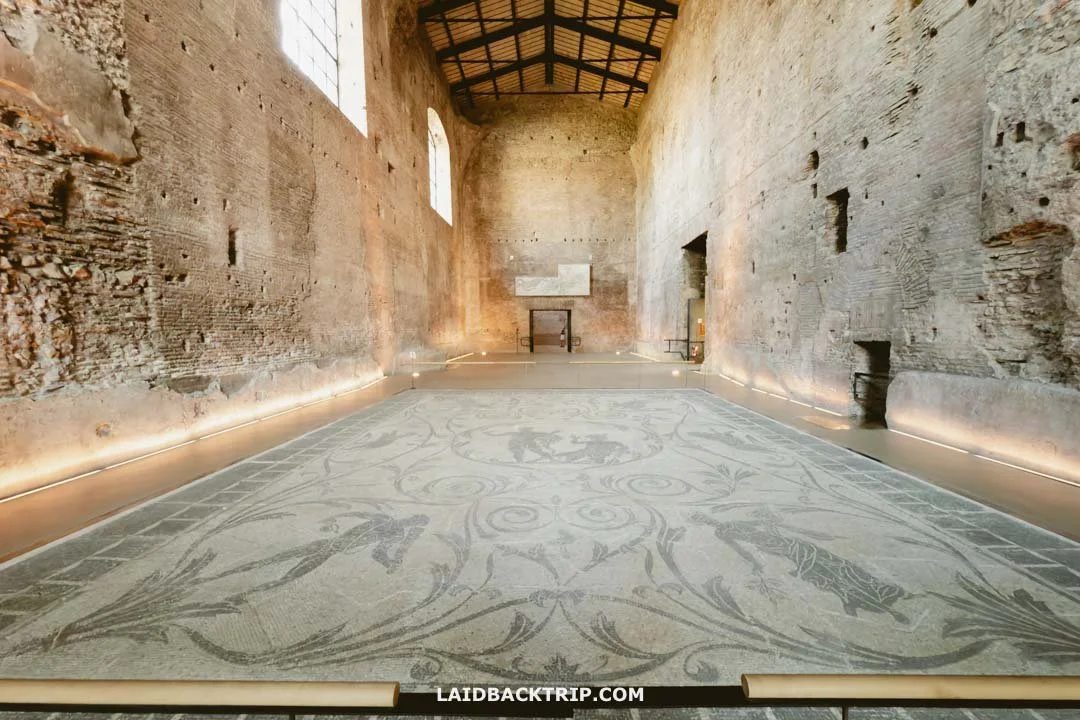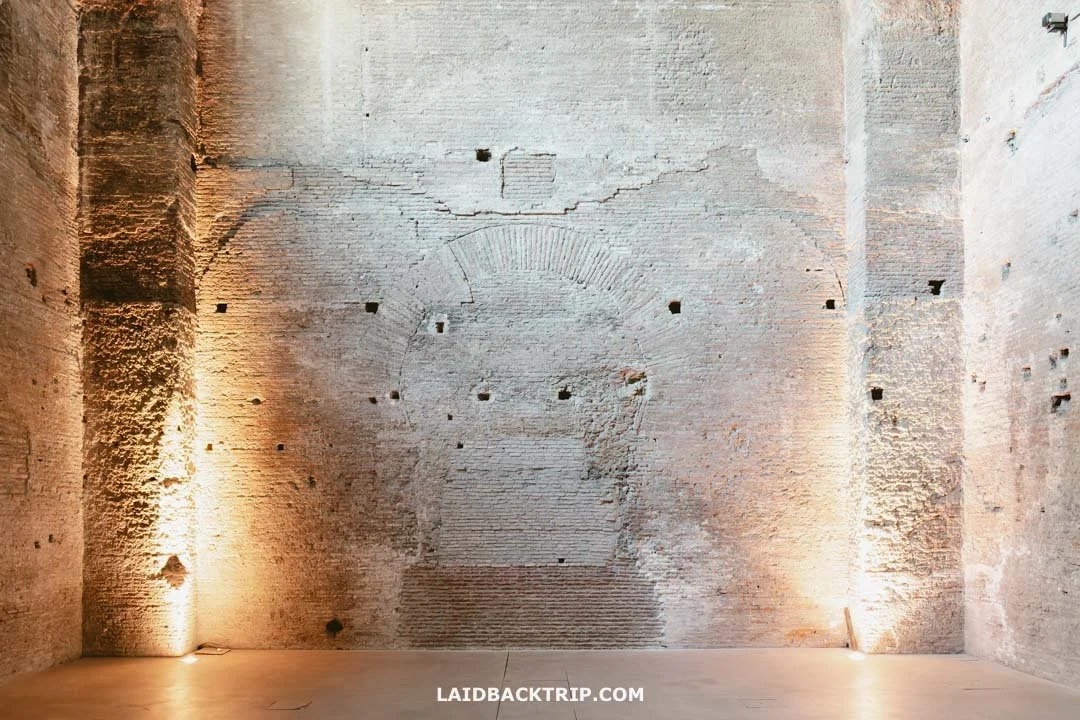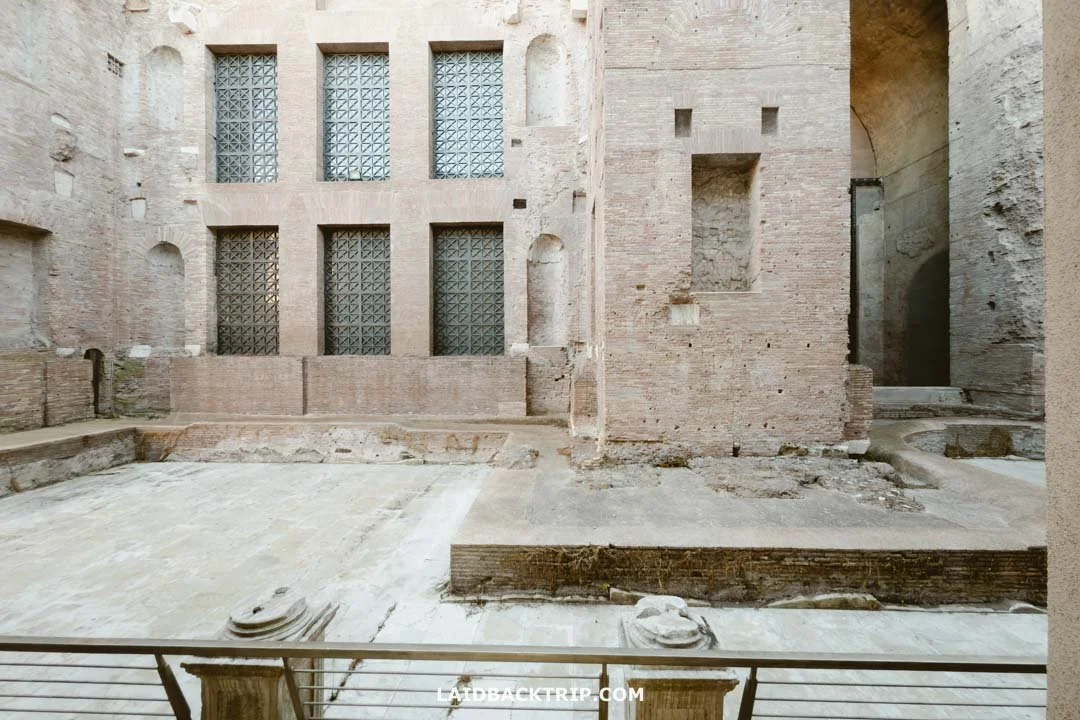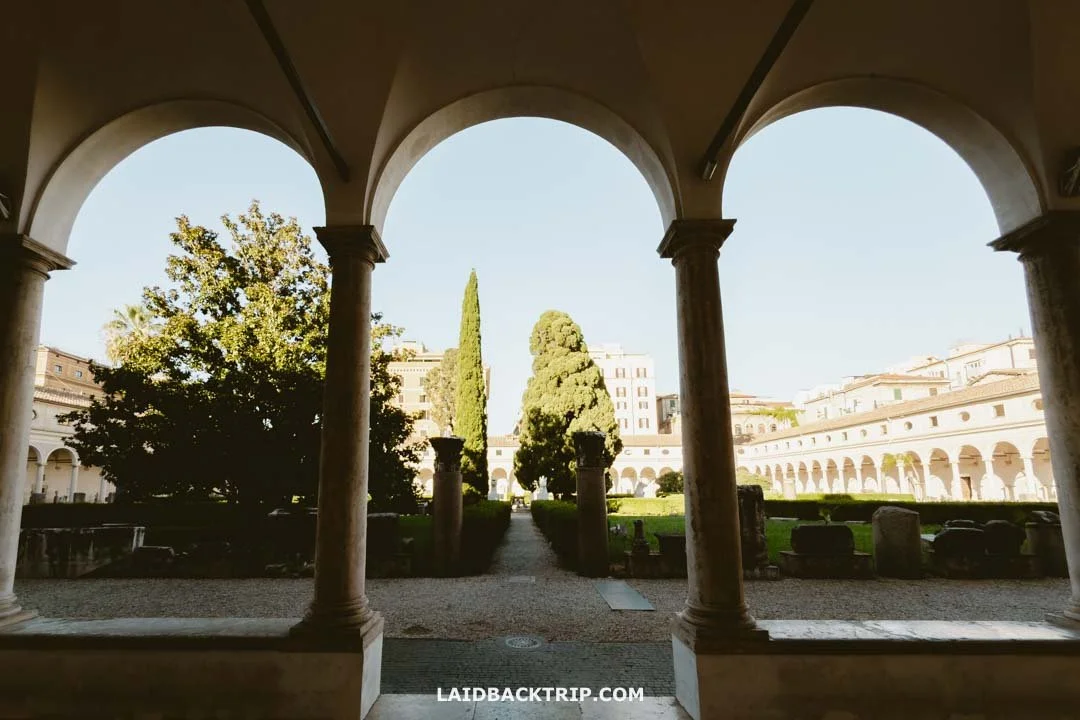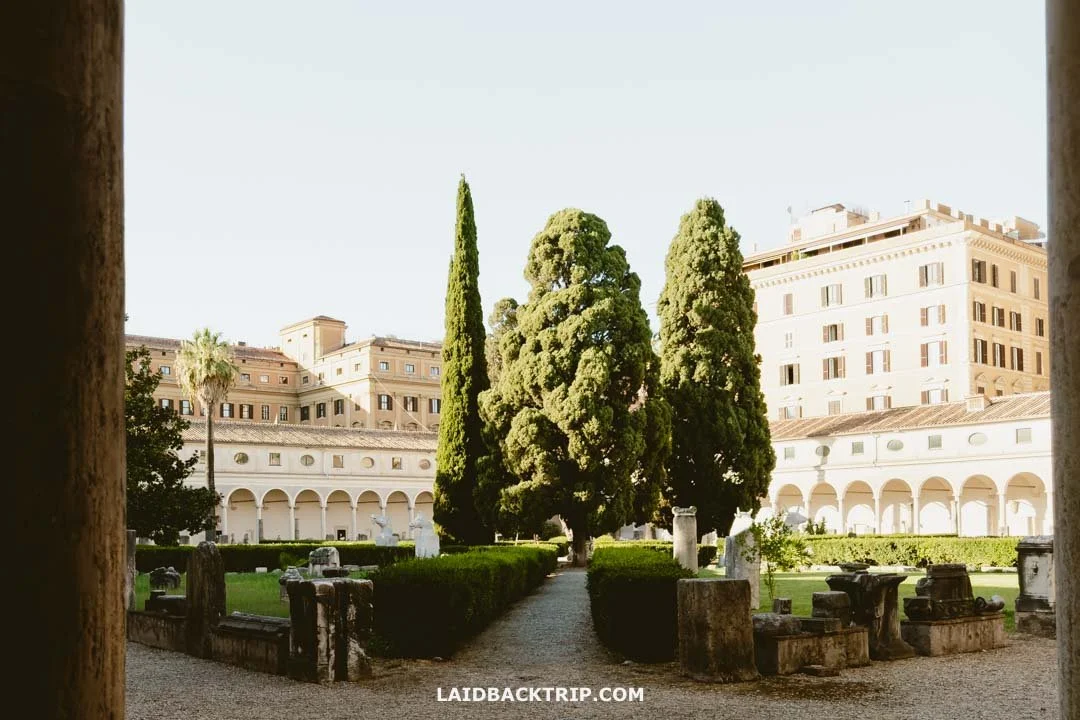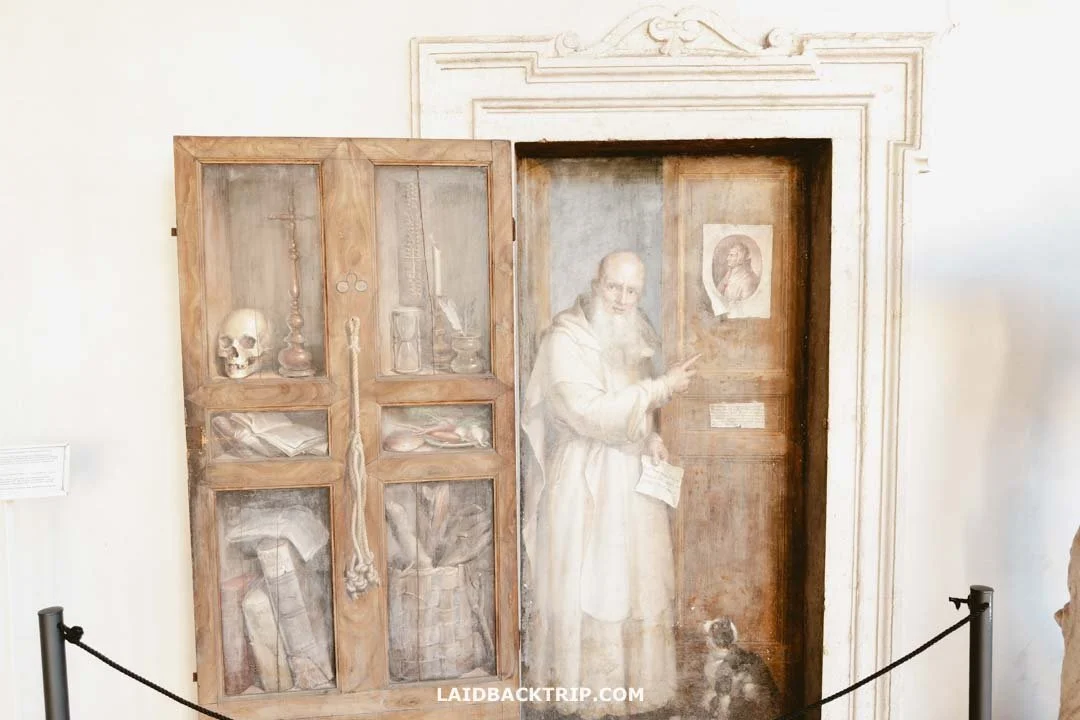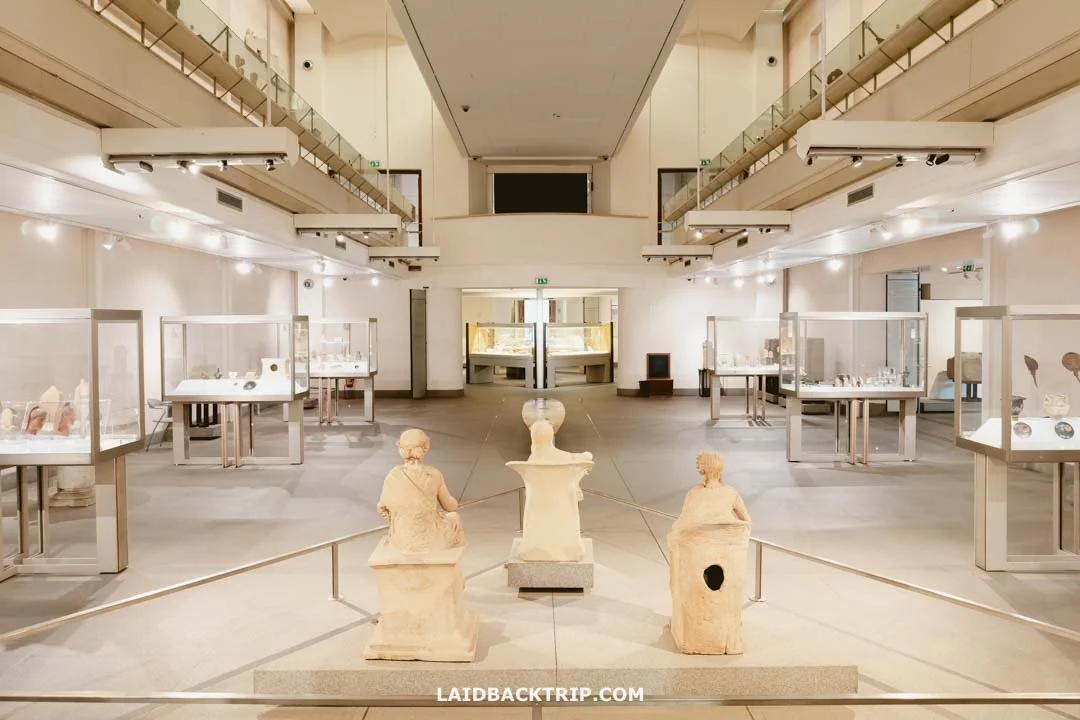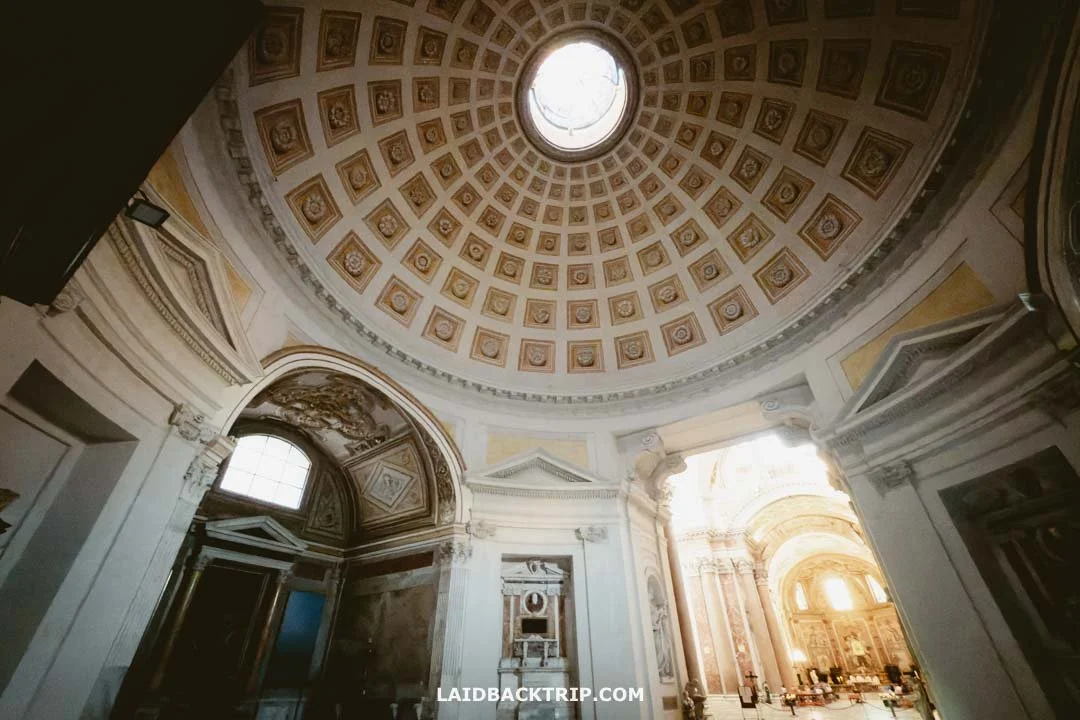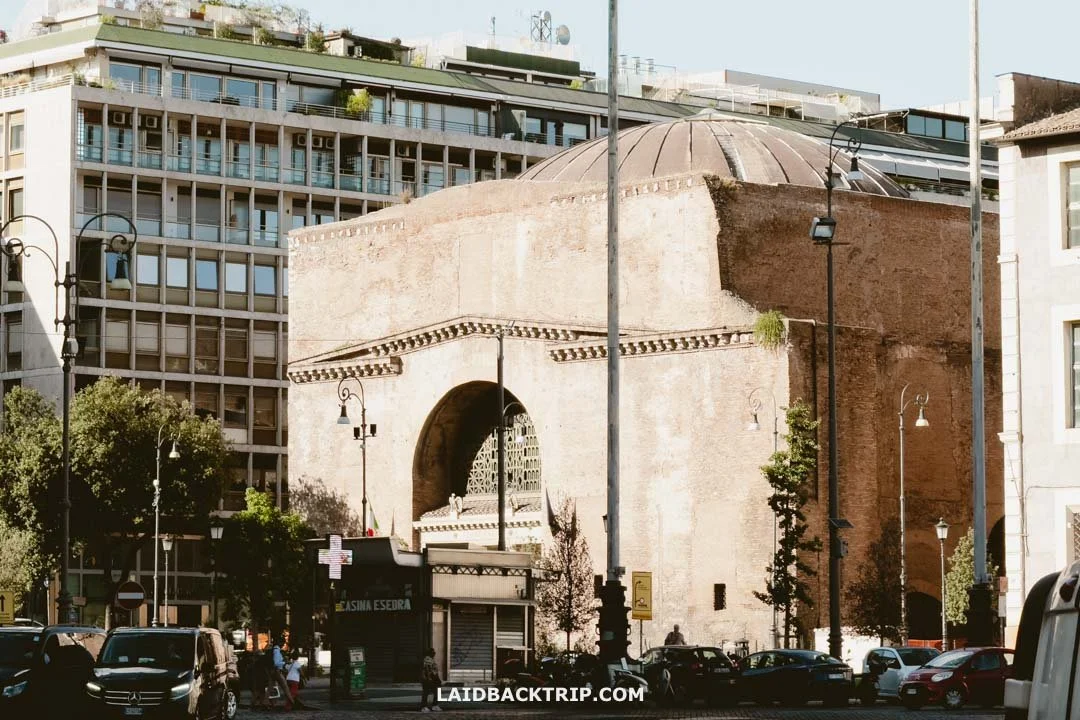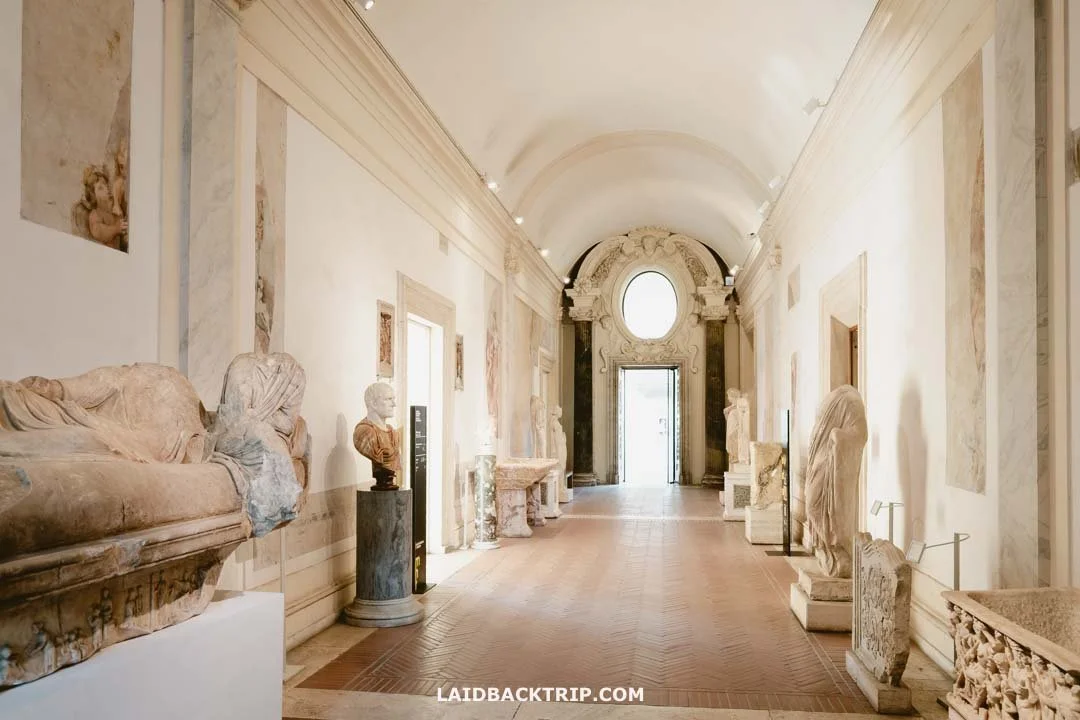How to Visit the Baths of Diocletian
The Baths of Diocletian took us off the beaten path.
Once the greatest of Rome's ancient baths, the Baths of Diocletian today are among the city's most remarkable museums.
Commissioned in 298 CE by Maximian and finished in 306 CE by Constantius, the Baths of Diocletian were the biggest bath complex ever built in Ancient Rome. Basically, from day one we arrived in Rome, Lucie insisted we had to check them out.
I was into the idea as well, but I pointed out that our list was already packed with similar spots. And honestly, I kind of wanted to see the Baths of Caracalla more. Still, after a few quick changes to our plans, we actually made it to both.
Over our eight days in Rome, we had the chance to check out all kinds of ancient ruins, from big sites like the Colosseum and Roman Forum to lesser-known places like the Stadium of Diocletian.
And while all of them were incredible, it was the Baths of Diocletian that gave us probably the most surprising experience. I was honestly stunned, because what I thought would be a straightforward trip into ancient Rome turned out to be way different from what I expected.
The Baths of Diocletian contain ruins of a bathhouse, Renaissance cloisters, a large basilica, and a Roman museum.
Okay, maybe I'm exaggerating a bit here, but since I barely knew anything about the Baths of Diocletian, just that they were the largest in ancient Rome, I figured the visit would be totally different.
Without giving away too much, the two coolest things we noticed were that even though these baths were once massive, it honestly felt like we'd stumbled onto a hidden, off-the-beaten-path spot. And, at the same time, the place offered way more than just the baths themselves.
So, what set the Baths of Diocletian apart, and what made our visit so enjoyable? Here's what we discovered!
How to Get to the Baths of Diocletian
Since the Baths of Diocletian were right between the Piazza della Repubblica and Termini Station, and by the time we decided to visit, we'd already moved to the nearby Leonardo Boutique Hotel, it was basically a given that we'd get there on foot.
There honestly wasn't any reason to consider another way of getting there. The hotel was under a kilometer from the entrance, so it only took us about 10 minutes to reach the Baths of Diocletian (maybe a little longer because we stopped for a quick pasta on the way).
The Baths of Diocletian sit right by Piazza della Repubblica and Termini Station.
A few days before, we'd stayed at the cozy Hotel Navona, right next to the famous square. If we'd tried to walk from there, though, it actually would've been a much longer hike, almost three kilometers.
Since the Baths of Diocletian are right next to Termini, it's super easy to get there by metro, since both the A and B lines stop here. Tons of buses also come to Termini, so if you don't feel like walking to the museum as we did, public transportation gives you plenty of options.
Honestly, if you're staying a bit further away or even out on Rome's outskirts, the metro is definitely the best and fastest way to get to the Baths of Diocletian.
Tips on Accommodation Near the Baths of Diocletian
Termini is in such a strategic spot that we actually came here more than once, not just to visit the Baths of Diocletian. For example, we used it as our starting point to travel to Tivoli and Via Appia Antica, plus we also traveled from here to the Ciampino airport.
If you're thinking about staying in this area, Hotel Le Petit and Hotel Maximus are both pretty popular picks.
Tickets to the Baths of Diocletian at the Site
When we got to the Baths of Diocletian without pre-booking tickets, we honestly didn't expect a big line. It turned out, we were right. What did surprise us was that the ticket office was almost completely empty when we walked in.
There weren't any tourists around, and for a second, we weren't even sure the place was open. It only looked open because there was a staff member sitting at the desk.
When we tried to buy tickets at the desk, a lady working there just pointed to the ticket machine next to her. She let us know tickets to Baths of Diocletian cost €15 per person and actually include entry to three more sites, all managed by the National Museum of Rome.
We bought our tickets at this ticket machine.
After paying more to visit places like the Vatican Museums (we had to do a guided tour there), or the Capitoline Museums, this really felt like a great deal. To be fair, the Baths of Diocletian are much less famous.
The only small downside was that we didn't know anything about the other sites included with the ticket, but that didn't stop us from feeling like we scored a bargain.
We also found out that a big part of the experience was waiting for us at the adjacent Basilica of St. Mary of the Angels and of the Martyrs. It turned out to be a regular church (and a separate site) with no admission fee. Though calling it 'regular' is a stretch since there was nothing ordinary about it.
The ticket also gave us access to these three additional sites.
So for €15, we could check out not just the Baths of Diocletian, but also the Aula Ottagona, Palazzo Massimo, and Palazzo Altemps. There's also a place called Crypta Balbi, but the ticket doesn't work for that one. I'd still call it a fantastic deal, since we got to see Palazzo Massimo and Palazzo Altemps the next day. So, yeah, basically four museums for less than four euros each.
The official Baths of Diocletian site is under Museo Nazionale Romano on the Beni Culturali website. But when I checked later to buy tickets online, I was redirected from there to Musei Italiani, which is another official website. Here we bought tickets to places like the Pantheon or Villa dei Quintili. But honestly, there was no need to get tickets online, since the Baths of Diocletian just aren't that popular.
Opening Hours
During our visit, the Baths of Diocletian were open from 9 AM to 7 PM Tuesday through Sunday, and closed on Mondays. Last entry was at 6 PM. We went on a weekday afternoon in September, and honestly, the place was about as quiet as it gets.
Exploring the Baths' Halls
With our tickets in hand, we made our way over to Aula X, the first massive part of the original Baths of Diocletian. We had to head back through the garden we'd come in by. This part of the museum consisted of several huge halls (named Aula X, XI, etc.), with some smaller ones adjacent to them.
As we entered, we noticed the funerary steles and tombstones scattered around the park and took a closer look at a few. But only a few, as we couldn't wait to get into the bathhouse. So that's where we headed after a bit.
The first of the baths' halls we saw was Aula X.
Ancient Tombs
Like I said earlier, we came to check out the Baths of Diocletian without knowing much about the place. When we started our self-guided tour and walked into the first massive hall, we were honestly surprised to spot a few ancient tombs inside. There was some info about the hall and a bit about the baths, but honestly, we pretty much skipped that at first since the tombs totally grabbed our attention.
The Tomb of the Platorini Family was found in 1880 in Lungara on the Tiber's right bank.
So, these reconstructed chamber tombs were actually found in other parts of Rome and brought here to be preserved and shown to visitors. We thought it was fascinating to get a glimpse into ancient Roman burial traditions, although we wished there had been a little more detail about what we were seeing. Honestly, we also wondered why the tombs were there at all, but apparently, it's because this spot isn't just a bath museum.
One of the two chamber tombs we found in Hall X had these beautiful paintings.
History of the Baths of Diocletian
At this point, we started to realize that our visit to the Baths of Diocletian might end up being a bit different from what we had thought. First, though, we got to see more of the baths, or at least the section that survived for over 1700 years.
As I mentioned earlier, construction on these impressive Roman baths started in 298 CE and officially finished in 306 CE, so they were built in just eight years. Considering their size and that they could fit 3,000 people at the same time, that's pretty wild. Their design was a lot like the Baths of Caracalla, but these were just bigger.
In the small cloister, there was a model of the Baths of Diocletian as they look today.
The buildings were made with bricks, then covered in marble and decorated with beautiful mosaics and sculptures. With about 120,000 square meters, the whole facility was enormous, and it had all the key features, like a gym, a library, and the classic cold, hot, and warm pools combo.
The baths shut down when the Goths destroyed the aqueducts in the 6th century CE, cutting off the water supply. Without water, the baths simply lost their purpose. In a nutshell, that's the story of the Baths of Diocletian in ancient times, but there's a lot more to it, which I'll talk about in the next section.
Roman Ruins at the Baths of Diocletian
We'd already seen the tombs, so it was finally time to check out the spot we were standing in. Looking up, the hall was honestly gigantic. The funny thing was, as amazing as these old structures were, what we were actually seeing was just two big halls and another outside with its roof partly fallen in.
Once we left the first hall, we headed into another massive space, Aula XI, which was actually a water reservoir back in the day. The walls were plastered up to five meters tall, and the room was filled with water that fed into the baths. Lucie joked that the Romans missed the opportunity to turn it into a giant diving pool.
Aula XI, which was once a giant water tank, had no water but beautiful mosaics.
What was funny was that, except for these three areas, that was basically all we saw of the Baths of Diocletian as far as the ancient Roman baths go. There were a couple of ruins in the garden out front, but really, that was it. We realized we'd only seen a tiny area of the whole place.
At this point, we finally learned what happened to the Baths of Diocletian after they were abandoned. Since we'd been in Rome for a few days, we already kind of expected what was coming next. The bath complex became a huge quarry for building materials over the following centuries. That kind of thing happened a lot in the Medieval period, and a bunch of Roman structures went through the same thing.
Things took a big turn in the Renaissance. In the 1500s, Pope Pius IV put Michelangelo in charge of turning the massive Roman remains into a new church, which ended up as the Basilica of St. Mary of the Angels and of the Martyrs.
Aula IX served as the changing room (apodyterium) right by the entrance.
Alongside that, a huge Carthusian Monastery was built within the old bath walls, turning the former halls into cloisters and storage for the city's food. This clever reuse kept the complex from being completely destroyed.
At this point, Lucie asked if this was all there was to the experience, and honestly, I wondered the same thing. But it turned out there was a lot more to see at the Baths of Diocletian. We kept going further into the museum and found two cloisters, plus some other cool surprises. For example, there was actually a big museum packed with Roman history.
Self-Guided vs. Guided Tour at the Baths of Diocletian
We explored the Baths of Diocletian by ourselves, and while we figured out a lot on our own, there were a few times when having a guide would have been useful.
The Small Cloister
From here, we wandered deeper into the complex and ended up at a small cloister (Ludovisi Cloister) built right over part of the natatio (a large pool about one meter deep, where Romans cooled off after hot baths). Once again, we were basically the only people there. Usually, that would be awesome, especially since the cloister looked really beautiful.
The atmosphere was so calm, it honestly felt like we were in Villa de Leyva and not in the heart of a huge European city. The cloister was small, and except for a couple of trees, there was a lovely water well right in the center.
In Roman times, the enormous open-air swimming pool was here.
But after spending a few seconds in the courtyard, we noticed it wasn't actually all that quiet. There was a noise we soon figured out was religious chanting.
I'm no expert in religious chants or Latin, but these ones were about as far from happy as you can get. The chants echoed through the cloister, and since nobody else was around, the whole thing felt pretty spooky. It was kind of like something out of The Shining.
While we were soaking in this lovely atmosphere, we also got to see a bit more of the original baths. Some remains were right there in the cloister, but the coolest part was the foundations of the Roman pools, which were behind a glass wall that separated us from the Basilica of St. Mary of the Angels and of the Martyrs.
Here's what remains of the natatio at the Baths of Diocletian.
Michelangelo Cloister
Next, we made our way to the Michelangelo Cloister, which turned out to be another big surprise at the Baths of Diocletian. This huge space was created by the renowned Michelangelo di Lodovico Buonarroti, whose art we had already admired as he painted the magnificent frescoes of the Sistine Chapel, which we visited only a few days ago.
The Michelangelo Cloister had beautiful arcades.
Inside this masterpiece of Renaissance architecture, we found a bunch of more interesting things. For one, the rectangular cloister was massive, almost 100 meters long on each side and lined with 100 solid travertine columns holding up the arcades.
Something else that caught our eye was the trees in the middle of the cloister. There were four cypresses, and one of them was basically just a trunk propped up by metal (it had been struck by lightning). At first, it seemed strange, but then we learned that, by tradition, Michelangelo planted these trees himself, making them 500 years old!
The cypresses in the middle were allegedly planted by Michelangelo.
As we wandered around, we discovered that the arcades and porticoes were filled with an interesting collection of ancient Roman artifacts consisting of sarcophagi, funerary altars, grave markers, inscriptions, and seven huge animal heads. We even spotted a trompe-l'oeil painting that made it seem like a Carthusian monk was looking out from a doorway.
A trompe-l'oeil painting of a Carthusian monk.
But the most surprising thing about the Michelangelo Cloister was how quiet it was. In the earlier parts of our visit, we saw tourists every now and then, but here we were totally on our own. It was kind of eerie that such a massive place barely had any visitors.
The Museum of Written Communication in the Roman World
The only gap in our plan was that we didn't realize there'd be a big museum here, so we had to be a bit choosy about what to check out next. The museum looked super nice and modern, with two main exhibitions: Written Communication in the Roman World and Protohistory of the Latin People.
The museum was full of pre-Roman and Etruscan artifacts.
It was around here that we began to run out of time and realized we really should have budgeted more for the Baths of Diocletian. Even so, we still got to see some cool artifacts and learn more about Roman history.
The Tomb of the Warrior from Lanuvium dates back to 475 BCE.
Basilica of St. Mary of the Angels and of the Martyrs
With just over 20 minutes left, we rushed to the Basilica of St. Mary of the Angels and of the Martyrs before closing time. Even though both spots are part of one huge complex, we still had to walk almost 400 meters to get from the Baths of Diocletian to the basilica entrance.
We had to walk down a busy, traffic-filled road, which wasn't exactly a highlight, but it did remind us just how massive these baths used to be. The biggest surprise, though, was still ahead.
The entrance to the Basilica of St. Mary of the Angels and of the Martyrs used to be part of the old bathhouse.
Like I said earlier, the Basilica of St. Mary of the Angels and of the Martyrs is technically its own spot and is free to enter. To be honest, when we got to the entrance, it looked like it'd just be a small church. The surprising part was that, instead of the usual grand facade you see on other famous churches, the front was actually a curved wall from the ancient Roman baths.
When we went inside, we stepped right into a rotunda-shaped hall with a dome that looked a lot like the famous Pantheon, just smaller, and with its oculus covered.
This circular room was originally the Tepidarium, the lukewarm bath hall.
Throughout our days in Rome, we came across some really spectacular churches. The Basilica of St. Mary of the Angels and of the Martyrs was just as interesting as some of the most famous ones, though not in the way we might have thought.
The Basilica of St. Mary of the Angels and of the Martyrs is a separate site today.
In 1561, Pope Pius IV put Michelangelo Buonarroti in charge of designing this church, and he worked his plans into the Roman ruins that had been standing there for over a thousand years. Michelangelo actually kept a lot of the original structure, turning the huge rectangular hall of the frigidarium into the church's transept.
Because of this, the ceiling at the Basilica of St. Mary of the Angels and of the Martyrs ended up being really unique. It's plain and simple, with no frescoes or decorations at all.
The Church of St. Mary of the Angels preserves the original ceiling from the Roman bathhouse.
Everyone talks about the Pantheon's dome and how it's a marvel of Roman engineering. But honestly, from my perspective, the huge cross-vaulted ceiling over the main hall (now the transept) that survived from Roman times was just as spectacular.
When I mentioned how quiet the Baths of Diocletian were, the basilica was only a little busier (since it's a working church), but considering its size, it still felt pretty empty.
One of the side rooms had an exhibit about both the Baths of Diocletian and the basilica, but since it was close to closing time, the lights were off, and we had to squint to read the panels since there just wasn't enough natural light.
The basilica also had some basic information in English on the Baths of Diocletian.
If we'd been on a tight budget or short on time, we probably would have skipped the Baths of Diocletian, since this was really the best-preserved part of the whole complex, as odd as that sounds. But that wasn't the case this trip, and we ended up really enjoying the museum too.
The Octagonal Hall
The Octagonal Hall was originally part of the Baths of Diocletian, but now it exists as a separate building. In 1928, the Hall became a Planetarium. Even though it was removed in the 1980s, it is still often referred to simply as Planetario.
The site sits right next to the Basilica of Saint Mary of the Angels and Martyrs and is accessed from Piazza della Repubblica. It is mostly one large hall with a few artifacts, making it a small site.
The ticket we bought included this site, but the day we visited the Baths of Diocletian it was already closed, and in the days that followed we didn’t get a chance to go inside.
We saw the Octagonal Hall only from the outside.
Travel Insurance
We never leave home without travel insurance that was designed to cover our expenses if something goes wrong during the trip. Travel insurance protects against theft, flight delays, injury, illness, cancellations, and much more. Travel smarter and safer!
World Nomads provides travel insurance for travelers to cover their trip essentials, including sports and adventure activities.
SafetyWing is affordable travel insurance for backpackers, long-term travelers, and digital nomads.
How Much Time to Set Aside for the Baths of Diocletian
Since we ended up at the Baths of Diocletian later in the day, we only had about two and a half hours before closing. The tricky part was that both the baths and the Basilica of St. Mary of the Angels and of the Martyrs closed at 7 PM, and after learning more about the place, we definitely wanted to check out the basilica as well.
If we had had more time, we could have easily spent a few more hours exploring the Baths of Diocletian.
In the end, we figured 20 minutes would have to be enough for the basilica, which gave us just over two hours for the Baths of Diocletian. All things considered, that time worked out okay, but we do wish we'd had at least another hour for the museum. Honestly, the visit to the basilica felt a little rushed, too.
Since we only found out what was included in the combo ticket after getting to the baths, we missed out on seeing Palazzo Massimo alle Terme, which is only about 200 meters away. Luckily, we were staying nearby, so we managed to visit the next day. If we'd been short on time, though, it would have been way better to see both places at once.
Are the Baths of Diocletian Worth Visiting?
While a visit to the Baths of Diocletian wasn't a classic ancient Roman bath experience, this place turned out to be one of the most interesting spots we saw in Rome. The Baths of Diocletian were the biggest bath complex in Ancient Rome, and even though they've changed over time, there's still a lot to discover, whether you're into architecture or history.
While they were once the largest in the Roman Empire, nowadays the Baths of Diocletian are much less crowded than we expected, making them a real hidden gem in Rome. After visiting packed places like Trevi Fountain and St. Peter's Basilica, stumbling across a peaceful spot where we could get away from the crowds was a great surprise.
The Baths of Diocletian were among the largest complexes ever built by the Romans.
So, when it comes to Roman baths, we think the Baths of Diocletian are definitely one of the top places to visit in Rome. They're especially rewarding if you have extra time to dive into ancient architecture, history, and how the site changed in the Middle Ages. That brings me to one last tip.
We were also glad that we got to see the Basilica of St. Mary of the Angels and of the Martyrs, which, even though it's technically a separate site, really made the whole experience better. Honestly, seeing the Baths of Diocletian without the basilica just wouldn't feel complete.
Travel Resources
Here you can find links to all the travel resources we use and which you might find helpful when planning your next holiday.
Accommodation: When looking for accommodation, we usually search hotels via Booking.com or Hostelworld.
Tours: Although we love to travel independently, some places are better to visit with a guided tour.
We prefer GetYourGuide for its easy-to-use interface and solid reputation. Another great alternative is Viator.
Rental Cars: When going on a road trip, we always use Rentalcars.com, a reliable site for booking a rental car in advance.
Flight Tickets: When looking for flight tickets, you can search Skyscanner to find the best price.
Travel Insurance: World Nomads and SafetyWing cover against risks of travel.
